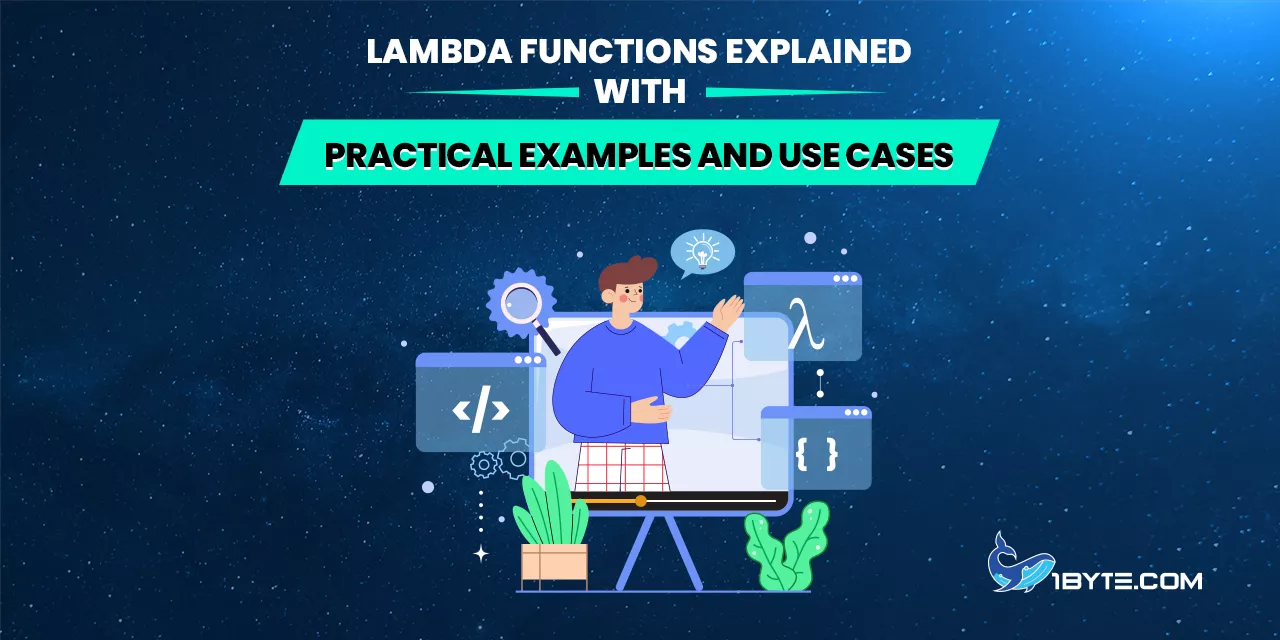Lambda functions allow developers to define short, anonymous functions in many programming environments. They are found in the mainstream languages (Python, JavaScript, Java, C#, etc.) and in cloud services such as AWS Lambda. As part of the broader serverless trend, Lambda functions are growing rapidly – Gartner predicts the serverless market (which includes platforms like AWS Lambda) will reach $311 billion by 2024. These are brief functions that are used to simplify code and automate functions. An example is a Python lambda x: x*2, which is an implementation of a fast doubling code with factless design. Across industries, Lambda usage is rising: a Datadog study found that over 70% of AWS customers use at least one serverless service, and nearly half of AWS accounts were running Lambda functions by 2020. This article from 1Byte examines what Lambda functions are, how they work in code and cloud environments, and explores practical examples and use cases.

Lambda Functions in Programming Languages
Lambda functions (or lambda expressions) provide a concise way to write small functions. Most of the contemporary languages promote them. The python language employs the lambda keyword. A lambda in Python is a tiny anonymous Python function expressed in a single line. As an example, lambda x, y: x + y is an addition of two numbers. The lambdas of Python can only have one expression, which makes them appropriate in simple tasks. They tend to be used with higher-order functions: as an example, passing a lambda to map, philtre or reduce to do terseminary data processing.
- Python: A lambda is defined like lambda x: x*2. Such lambdas are ideal for quick, one-off calculations. As FreeCodeCamp notes, Python lambdas are limited to a single expression and are typically used for straightforward operations. For example, sorted(list_of_pairs, key=lambda pair: pair[1]) sorts a list by the second element without a named function.
- JavaScript: In ES6 and later, JavaScript’s arrow functions (x => x*2) act like lambdas. They let you write inline functions (often called “anonymous functions”) for callbacks, array methods, or event handlers.
- Java: Java 8 introduced lambda expressions for functional interfaces. A Java lambda uses the -> syntax to separate parameters from the body. For example (a, b) -> a + b is a concise function that adds two numbers. GeeksforGeeks explains that a Java lambda consists of an argument list, an arrow token, and a body.
- Other languages: C# uses lambdas (e.g. x => x*2), and many functional languages (like Scala or Kotlin) have similar constructs. In all cases, lambdas enable inline, unnamed functions for quick tasks.
Lambda Functions in Data Processing
Lambda functions shine in data processing and functional programming contexts. They allowed code to be smaller through the exclusion of boilerplate. E.g. To square every item of a list of numbers you can write map(lambda x: x x, numbers) in Python instead of defining a proper function. There are numerous tutorials that stress the fact that lambdas perform well with such functions as map, philtre, and reduce. The higher-order functions accept other functions to be their arguments.
Practically such translates to developers being able to inline write transformations. As an example, to sift out even numbers of a list in python: list(filter(lambda x: x mod 2 = 0, numbers)). Or in JavaScript: [1,2,3,4].filter(x => x % 2 === 0). Lambda functions keep such code compact. Nevertheless, since they can only permit one expression (in Python), intricate logic is preferable to be coded in named functions. To conclude, lambdas make it easy to perform simple tasks on data without the formality of a full-fledged function definition.
AWS Lambda and Serverless Compute
Beyond language syntax, “Lambda functions” often refers to cloud functions like AWS Lambda. AWS Lambda is a service that runs code in response to events (such as file uploads or API calls) without server management. Major cloud providers offer similar services (Azure Functions, Google Cloud Functions). These platforms are hugely popular: one report notes that the majority of organizations on AWS or Google Cloud have at least one serverless deployment. In 2023, Datadog found that Python and Node.js dominated AWS Lambda workloads and that many enterprises (especially large ones) rely on Lambda for production workloads.
Datadog data shows how pervasive serverless has become. Over 70% of AWS customers now use one or more serverless solutions. In fact, nearly half of AWS users ran Lambda functions by early 2020. This broad adoption underscores how Lambda functions power many modern applications.
Common AWS Lambda use cases include:
- APIs and Microservices: Integrating Lambda with Amazon API Gateway creates scalable, secure REST APIs. API Gateway can trigger a Lambda on each HTTP request and return the result, enabling serverless backends.
- Scheduled Tasks (Cron Jobs): Using CloudWatch Events (now EventBridge) to trigger Lambdas on a schedule. For example, run a Lambda daily for database maintenance or hourly to refresh dashboards. This replaces traditional cron servers with fully managed scheduling.
- Event Processing (SNS/SQS): Lambdas excel in event-driven pipelines. An Amazon SNS topic can invoke a Lambda for each published message (e.g. processing transactions). Similarly, Lambda can poll an SQS queue, processing messages in order, which is useful for tasks like order processing in e‑commerce.
- File and Data Pipelines: Trigger Lambdas on S3 file uploads. For instance, when an image is uploaded, a Lambda can automatically run image recognition via Amazon SageMaker. Lambdas can process log files, perform ETL in data pipelines, or batch-process files without dedicated servers.
- Workflow Orchestration: Combine Lambdas with AWS Step Functions to build complex workflows. Each step in a business process (validation, execution, notification) can be a separate Lambda, managed by Step Functions with built-in error handling.
These patterns illustrate Lambda’s flexibility. Many enterprises use Lambdas as glue code or microservices, and Datadog reports show a tight correlation between container usage and Lambda adoption (80% of container users also use Lambda). In short, serverless functions like AWS Lambda have become a mainstay for building scalable, event-driven systems.

Benefits and Limitations
Lambda functions bring several benefits. Conciseness: They remove the boilerplate through the use of fast in-line functions. This is able to simplify code to be readable. Flexibility: Lambdas can be argued in languages or can be returned in functions, so that they can be used on a functional basis. The Lambdas grow automatically in the cloud. AWS Lambda is an infrastructure-based service, which means that a developer will only pay on a per-execution basis. It is a pay-as-you-go model which tends to save the expenses on peak workload. Scalability and Reliability: Scalability Cloud lambdas are managed by the provider and can be scaled to thousands of simultaneous functions or zero.
However, there are trade-offs. Language limits: Python Lambdas are limited, e.g. to a single expression. A named function instead must be used in complex logic or a multi-line operation. Readability and Anonymity Anonymous functions have neither a name nor a docstring and this may make debugging more difficult. Lambdas may cause the intent of code to be lost. Cloud-specific problems: There is the issue of cold-start latency in AWS Lambda. Light languages have shorter startup times than runtimes such as Java. According to datadog, Java Lambda cold starts are approximately three times longer than Python. The developers are supposed to strike the balance between languages and memory settings to enhance performance. Also, serverless architectures may cause vendor lock-in and have to be carefully managed in terms of costs.
Despite these drawbacks, lambda functions remain powerful. They are ideal for well-defined, single-purpose tasks. In Python, for instance, simple data transformations and callbacks fit naturally into a lambda. In the cloud, event-driven use cases (APIs, file processing, etc.) match Lambda’s model perfectly. As one industry report notes, serverless adoption continues to rise with increasing workloads (one study saw a 209% increase in Lambda invocations year-over-year in late 2019).
Conclusion
In conclusion, lambda functions simplify development in many domains. They enable concise code in applications and serverless architectures. With ongoing growth in serverless technology (predicted to reach $311B by 2024) and robust industry support, understanding Lambda functions and their use cases is essential for modern developers and organizations.

